Abstract
TiO2 has attracted significant interest owning to their excellent photocatalytic properties. However, controlled preparation of TiO2 with satisfactory morphology is still an urgent challenge in this field. In this work, tunable one-dimensional (1D) rod-like and three-dimensional (3D) yolk-like N-doped TiO2 hierarchical architectures were successfully fabricated by one-step solvothermal route. A comparative study on morphological, structural and optical behavior of 1D and 3D TiO2 is conducted by SEM, TEM, BET, XPS, UV–Vis DRS, photoelectrochemical and photodegradation experiments. The resultant N-doped TiO2 with specific surface area of 190.8 m2 g−1 and 166.6 m2 g−1 for rod-like structure and yolk-like structure, respectively, exhibited excellent photocatalytic performance using rhodamine B (RhB), methylene blue (MB) and phenol as the degraded pollutants under visible-light irradiation. Benefiting from the direct electrical path, multiple internal reflections of light and high specific surface area, the rod-like N-doped TiO2 possessed higher photocatalytic efficiency. Specifically, for rod-like N-doped TiO2, the reaction rate constant of the photodegradation for RhB, MB and phenol reached 12.1, 6.9 and 76.0 times, respectively, compared with P25. In comparison with yolk-like N-doped TiO2, the rate constant raised 1.5, 1.3 and 1.3 times. In addition, the formation mechanism of such controllable-morphology structure was also analyzed. This work suggests that the proper hierarchical structure combined with a large specific surface area plays a significant role on photocatalytic performance.











Similar content being viewed by others
References
Natarajan S, Bajaj HC, Tayade RJ (2018) Recent advances based on the synergetic effect of adsorption for removal of dyes from waste water using photocatalytic process. J Environ Sci-China 65:201–222
Nakata K, Ochiai T, Murakami T, Fujishima A (2012) Photoenergy conversion with TiO2 photocatalysis: new materials and recent applications. Electrochim Acta 84:103–111
Liang HJ, Jia ZC, Zhang HC, Wang XB, Wang JJ (2017) Photocatalysis oxidation activity regulation of Ag/TiO2 composites evaluated by the selective oxidation of Rhodamine B. Appl Surf Sci 422:1–10
Wang P, Jia CC, Li J, Yang P (2019) Ti3+-doped TiO2(B)/anatase spheres prepared using thioglycolic acid towards super photocatalysis performance. J Alloy Compd 780:660–670
Liu Q, Ding DY, Ning CQ, Wang XW (2015) Black Ni-doped TiO2 photoanodes for high-efficiency photoelectrochemical water-splitting. Int J Hydrogen Energy 40:2107–2114
Darbandi M, Dickerson JH (2016) Nanoscale engineering of TiO2 nanoparticles: evolution of the shape, phase, morphology, and facet orientation. Mater Lett 180:212–218
Sarkar B, Singhal N, Goyal R, Bordoloi A, Konathala LNS, Kumar U, Bal R (2016) Morphology-controlled synthesis of TiO2 nanostructures for environmental application. Catal Commun 74:43–48
He XY, Zhang CL (2019) Recent advances in structure design for enhancing photocatalysis. J Mater Sci 54:8831–8851. https://doi.org/10.1007/s10853-019-03417-8
Zha RH, Nadimicherla R, Guo X (2015) Morphology engineering of nanostructured TiO--2 particles. RSC Adv 5:6481–6488
Verbruggen SW (2015) TiO2 photocatalysis for the degradation of pollutants in gas phase: from morphological design to plasmonic enhancement. J Photochem Photobiol C 24:64–82
Dufour F, Pigeot-Remy S, Durupthy O et al (2015) Morphological control of TiO2 anatase nanoparticles: What is the good surface property to obtain efficient photocatalysts? Appl Catal B-Environ 174:350–360
Sambandam B, Surenjan A, Philip L, Pradeep T (2015) Rapid synthesis of C-TiO2: tuning the shape from spherical to rice grain morphology for visible light photocatalytic application. ACS Sustain Chem Eng 3:1321–1329
Chen Y, Li WZ, Wang JY, Gan YL, Liu L, Ju MT (2016) Microwave-assisted ionic liquid synthesis of Ti3+ self-doped TiO2 hollow nanocrystals with enhanced visible-light photoactivity. Appl Catal B-Environ 191:94–105
Lv J, Gao HZ, Wang HG et al (2015) Controlled deposition and enhanced visible light photocatalytic performance of Pt-modified TiO-2 nanotube arrays. Appl Surf Sci 351:225–231
Yu X, Zhao ZH, Zhang J, Guo WB, Li LL, Liu H, Wang ZL (2017) One-step synthesis of ultrathin nanobelts-assembled urchin-like anatase TiO2 nanostructures for highly efficient photocatalysis. CrystEngComm 19:129–136
Chen W, Wang Y, Liu S et al (2018) Non-noble metal Cu as a cocatalyst on TiO2 nanorod for highly efficient photocatalytic hydrogen production. Appl Surf Sci 445:527–534
Wang H, Wu D, Wu W et al (2019) Preparation of TiO2 microspheres with tunable pore and chamber size for fast gaseous diffusion in photoreduction of CO2 under simulated sunlight. J Colloid Interface Sci 539:194–202
Anwer S, Bharath G, Iqbal S et al (2018) Synthesis of edge-site selectively deposited Au nanocrystals on TiO2 nanosheets: an efficient heterogeneous catalyst with enhanced visible-light photoactivity. Electrochim Acta 283:1095–1104
Sharma PK, Cortes M, Hamilton JWJ, Han YS, Byrne JA, Nolan M (2019) Surface modification of TiO2 with copper clusters for band gap narrowing. Catal Today 321:9–17
Colomer MT, del Campo A (2019) Preparation of nanostructured TiO2 films with high catalytic activity and their 3D spatial distribution of anatase and rutile phases. J Mater Sci 54:9414–9425. https://doi.org/10.1007/s10853-019-03550-4
Devan RS, Patil RA, Lin JH, Ma YR (2012) One-dimensional metal-oxide nanostructures: recent developments in synthesis, characterization, and applications. Adv Funct Mater 22:3326–3370
Leng M, Chen Y, Xue JM (2014) Synthesis of TiO2 nanosheets via an exfoliation route assisted by a surfactant. Nanoscale 6:8531–8534
Mohan Kumar K, Godavarthi S, Karthik TVK et al (2016) Green synthesis of S-doped rod shaped anatase TiO2 microstructures. Mater Lett 183:211–214
Zhu K, Vinzant TB, Neale NR, Frank AJ (2007) Removing structural disorder from oriented TiO2 nanotube arrays: reducing the dimensionality of transport and recombination in dye-sensitized solar cells. Nano Lett 7:3739–3746
Li SS, Chang CP, Lin CC et al (2011) Interplay of three-dimensional morphologies and photocarrier dynamics of polymer/TiO2 bulk heterojunction solar cells. J Am Chem Soc 133:11614–11620
Zhang ZH, Wu HJ (2014) Multiple band light trapping in ultraviolet, visible and near infrared regions with TiO2 based photonic materials. Chem Commun 50:14179–14182
Lei BX, Liao JY, Zhang R, Wang J, Su CY, Kuang DB (2010) Ordered crystalline TiO2 nanotube arrays on transparent FTO glass for efficient dye-sensitized solar cells. J Phys Chem C 114:15228–15233
Gao M, Zhu L, Ong WL, Wang J, Ho GW (2015) Structural design of TiO2-based photocatalyst for H2 production and degradation applications. Catal Sci Technol 5:4703–4726
Lou XW, Wang Y, Yuan C, Lee JY, Archer LA (2006) Template-free synthesis of SnO2 hollow nanostructures with high lithium storage capacity. Adv Mater 18:2325–2329
Chen G, Cheng H, Zhang W, Yang Z, Qiu M, Zhu X, Chen M (2015) Template-free synthesis of single-/double-walled TiO2 nanovesicles: potential photocatalysts for engineering application. AIChE J 61:1478–1482
Yang J, Wen ZH, Shen XX, Dai J, Li Y, Li YJ (2018) A comparative study on the photocatalytic behavior of graphene-TiO2 nanostructures: effect of TiO2 dimensionality on interfacial charge transfer. Chem Eng J 334:907–921
Aoi Y, Kobayashi S, Kamijo E, Deki S (2005) Fabrication of three-dimensional ordered macroporous titanium oxide by the liquid-phase deposition method using colloidal template. J Mater Sci 40:5561–5563. https://doi.org/10.2472/jsms.53.1313
Paramasivam I, Jha H, Liu N, Schmuki P (2012) A review of photocatalysis using self-organized TiO2 nanotubes and other ordered oxide nanostructures. Small 8:3073–3103
Dong F, Zhao WR, Wu ZB (2008) Characterization and photocatalytic activities of C, N and S co-doped TiO2 with 1D nanostructure prepared by the nano-confinement effect. Nanotechnology 19:365607–365616
Chen K, Fan QH, Chen CL, Chen ZS, Alsaedi A, Hayat T (2019) Insights into the crystal size and morphology of photocatalysts. J Colloid Interface Sci 538:638–647
Li HX, Bian ZF, Zhu J et al (2007) Mesoporous titania spheres with tunable chamber stucture and enhanced photocatalytic activity. J Am Chem Soc 129:8406–8407
Zeng L, Song WL, Xie CS (2014) Fabrication of TiO2 rod in tube nanostructure with enhanced photocatalytic activity: investigation of the effect of the states of the precursor on morphology. RSC Adv 4:36708–36712
Yang XY, Peng HL, Zou ZM et al (2018) Diethylenediamine-assisted template-free synthesis of a hierarchical TiO2 sphere-in-sphere with enhanced photocatalytic performance. Dalton T 47:16502–16508
Ye T, Chen W, Xu H, Geng NN, Cai Y (2018) Preparation of TiO2/graphene composite with appropriate N-doping ratio for humic acid removal. J Mater Sci 53:613–625. https://doi.org/10.1007/s10853-017-1509-4
Yang GD, Jiang Z, Shi HH, Xiao TC, Yan ZF (2010) Preparation of highly visible-light active N-doped TiO2 photocatalyst. J Mater Chem 20:5301–5309
Li X, Liu P, Mao Y, Xing M, Zhang J (2015) Preparation of homogeneous nitrogen-doped mesoporous TiO2 spheres with enhanced visible-light photocatalysis. Appl Catal B-Environ 164:352–359
Kruk M, Jaroniec M (2001) Gas adsorption characterization of ordered organic-inorganic nanocomposite materials. Chem Mater 13:3169–3183
Liu C, Zhang L, Liu R et al (2016) Hydrothermal synthesis of N-doped TiO2 nanowires and N-doped graphene heterostructures with enhanced photocatalytic properties. J Alloy Compd 656:24–32
Lin Z, Waller G, Liu Y, Liu M, Wong C-P (2012) Facile synthesis of nitrogen-doped graphene via pyrolysis of graphene oxide and urea, and its electrocatalytic activity toward the oxygen-reduction reaction. Adv Energy Mater 2:884–888
Chen CS, Liu XY, Long H, Ding F, Liu QC, Chen XA (2019) Preparation and photocatalytic performance of graphene Oxide/WO3 quantum Dots/TiO2@SiO2 microspheres. Vacuum 164:66–71
Tian G, Chen Y, Bao H-L et al (2012) Controlled synthesis of thorny anatase TiO2 tubes for construction of Ag-AgBr/TiO2 composites as highly efficient simulated solar-light photocatalyst. J Mater Chem 22:2081–2088
Tian GH, Chen YJ, Zhou W, Pan K, Tian CG, Huang XR, Fu HG (2011) 3D hierarchical flower-like TiO2 nanostructure: morphology control and its photocatalytic property. CrystEngComm 13:2994–3000
Zhang Y, Wang CW, Hou HS, Zou GQ, Ji XB (2017) Nitrogen doped/carbon tuning yolk-like TiO2 and its remarkable impact on sodium storage performances. Adv Energy Mater 7:1600173–1600184
Bao Y, Kang QL, Ma JZ, Liu C (2017) Monodisperse hollow TiO2 spheres for thermal insulation materials: template-free synthesis, characterization and properties. Ceram Int 43:8596–8602
Hua Chun Z (2007) Ostwald ripening: a synthetic approach for hollow nanomaterials. Curr Nanosci 3:177–181
Nguyen DT, Kim K-S (2016) Self-development of hollow TiO2 nanoparticles by chemical conversion coupled with Ostwald ripening. Chem Eng J 286:266–271
Yang HG, Zeng HC (2004) Preparation of hollow anatase TiO2 nanospheres via Ostwald ripening. J Phys Chem B 108:3492–3495
Di Valentin C, Finazzi E, Pacchioni G, Selloni A, Livraghi S, Paganini MC, Giamello E (2007) N-doped TiO2: theory and experiment. Chem Phys 339:44–56
Prakash K, Karuthapandian S, Senthilkumar S (2019) Zeolite nanorods decorated g-C3N4 nanosheets: a novel platform for the photodegradation of hazardous water contaminants. Mater Chem Phys 221:34–56
Chen CS, Cao SY, Long H et al (2015) Highly efficient photocatalytic performance of graphene oxide/TiO2-Bi2O3 hybrid coating for organic dyes and NO gas. J Mater Sci-Mater Electron 26:3385–3391
Acknowledgements
This work was supported by the National Natural Science Foundation of China (51772102, 51972114, 51902107); the National Natural Science Foundation of Guangdong Province (2019A1515011002, 2019A1515011992); the Guangdong YangFan Innovative & Entrepreneurial Research Team Program (2016YT03C327); Project funded by China Postdoctoral Science Foundation (2018M643074, 2019T120728); and Fundamental Research Funds for the Central Universities (2019MS002).
Author information
Authors and Affiliations
Corresponding authors
Ethics declarations
Conflict of interest
No author has financial or other contractual agreements that might cause conflict of interest.
Additional information
Publisher's Note
Springer Nature remains neutral with regard to jurisdictional claims in published maps and institutional affiliations.
Electronic supplementary material
Below is the link to the electronic supplementary material.
Rights and permissions
About this article
Cite this article
Luo, B., Chen, W., Ma, J. et al. Fabrication of tunable 1D rod-like and 3D yolk-like TiO2 hierarchical architectures for efficient photocatalysis. J Mater Sci 55, 3760–3773 (2020). https://doi.org/10.1007/s10853-019-04247-4
Received:
Accepted:
Published:
Issue Date:
DOI: https://doi.org/10.1007/s10853-019-04247-4




